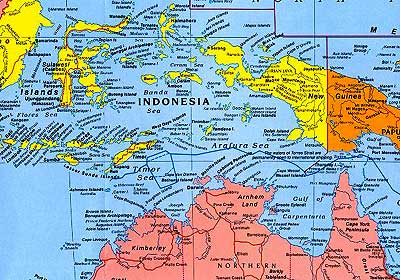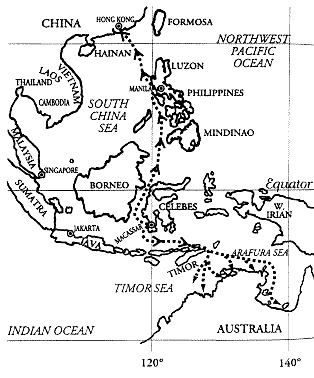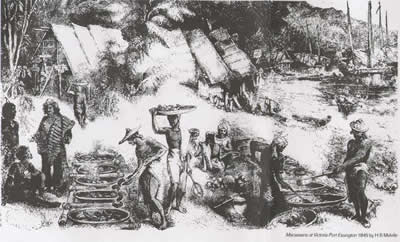|
Makassans
Makassans visited
the northern Australian coastline for three centuries and
possibly as long as six centuries, sailing seasonally from
Ujungpandang at the southwestern tip of Sulawesi to trade
with Aborigines (Cawte, 1996)
from the Kimberleys in the west, to as far as Mornington Island
in the east of the Gulf of Carpentaria.
Over this extraordinarily
long period of what appears to be quite harmonious contact,
a variety of objects, and even language, were adopted by many
people across the Top End. Tobacco, smoking
pipes, metal knives, dugout canoes, sails, flags and arrack
(alcohol) all became a part of traditional life. Still today
the rich music, language and ceremonial aspects of traditional
life in Arnhem Land reflect this contact.
Some makassans
made their home here, while some Yolngu from central and eastern
Arnhem Land travelled back to Ujungpandang. This
journey was re-enacted in 1993.

click on map for enlargement
Ujungpandang (Makassar) can be seen on this
map at the southwestern tip of the island of Sulawesi.
Makassans sailed
to the Arnhem Land coast in prahus
(also spelt prows, praus and perahus) on the winds of the
northwest monsoons each summer and returned with the southeast
winds about 3 months later. They came to collect the sea cucumber,
or sea slug (also known as trepang and beche-de-mer), prolific
in our northern waters. The Chinese believed the trepang held
great medicinal and aphrodisiac value. Yolngu do not use trepang
as it is poisonous (it contains a saponin - holothurian glucoside),
but once prepared correctly, is free of the poison. According
to Cawte, "For centuries Chinese merchants engaged caravels
to go to the unknown South Land to garner it by the tonne
from those shores and take it to Timor, whence their own junks
sailed it home to the local markets to sell for food and medicine".
After 1901, this trade became prohibited by the Commonwealth
of Australia, and it finally came to a halt in 1906.

Map showing trade route used by makassans to
northern Australia and China (from Cawte, 1996).

click on map for enlargement
'Macassans
at Victoria, Port Essington, 1845, by HS Melville.'
from a flyer for the Australian National Maritime
Museum exhibition, 1997.
The trepang were
collected by spearing, diving or dredging. Divers (many of
whom were Aboriginal) worked in up to 14 metres of water,
bringing up 10 trepang at a time in woven bags. For dredging,
dugout sailing canoes operated in pairs, scooping trepang
from the seabed.
The trepang were
prepared for travel by first splitting them open, boiling
in seawater and pressing them under sand or stones. The body
was stretched open with slivers of bamboo and preserved by
sun-drying and slow smoking in smoke houses. The makassans
brought with them "ready-made thatch panels for camp buildings,
iron boiling pots, rice and other supplies" (Australian
National Maritime Museum exhibition, 1997) and they introduced
to the Yolngu, among other things, tobacco, liquor, iron tools,
dugout canoes, sails, a variety of cultural practices and
language.
Cawte quotes an
extensive passage from Lt. Matthew Flinders journal, published
in 1814, from his voyages 1801-03. Here is some of the more
relevant text;
".....on the
return of Lieutenant Flinders, were learned that they were
prows from Macassar, and the six Malay commanders shortly
afterwards came on board in a canoe. It happened fortunately
that my cook was a Malay, and through his means I was able
to communicate with them. The chief of the six prows was a
short, elderly man, named Pobassoo; he said there were upon
the coast, in different division, sixty prows, and that Salloo
was the commander in chief.....
.....According
to Pobassoo, from whom my information was principally obtained,
sixty prows belonging to the Rajah of Boni, and carrying one
thousand men, had left Macassar with the north-west monsoon,
two months before, upon an expedition to this coast; and the
fleet was then lying in different places to the westward,
five or six together, Pobassoo's division being the foremost.
These prows seemed to be about twenty-five tons, and to have
twenty or twenty-five men in each; that of Pobassoo carried
two small brass guns, obtained from the Dutch, but all the
others had only muskets; besides which, every Malay wears
a cress or dagger, either secretly or openly......
....A thousand
trepang make a picol, of about 125 Dutch pounds; and one hundred
picols are a cargo for a prow. It is carried to Timor, and
sold to the Chinese, who meet them there; and when all the
prows are assembled, the fleet returns to Macassar......."
This means that
each of the sixty ships was carrying around 100 thousand trepang
at about 6.2 tonnes - that's 6 million trepang (over 350 tonne)
- every summer for at least three centuries!!
Dried trepang is
still sold in Chinatown, Sydney for around $Aus20 a kilogram.
Want to have a
squizz at the Hati Marege
- a makassan perahu in the Northern Territory?
Further fascinating
information can be obtained by consulting:
Macknight, CC (1976) The Voyage to Marege' : Macassan trepangers
in northern Australia. Melbourne University Press. ISBN
0 522 84088 4.
|

